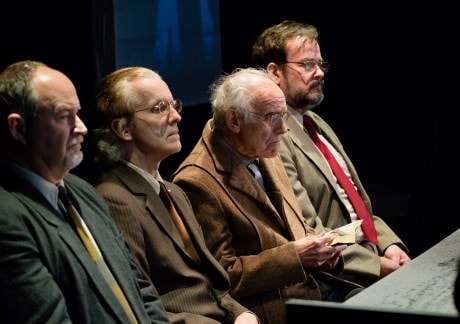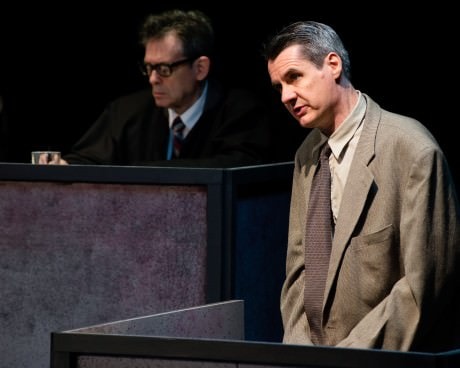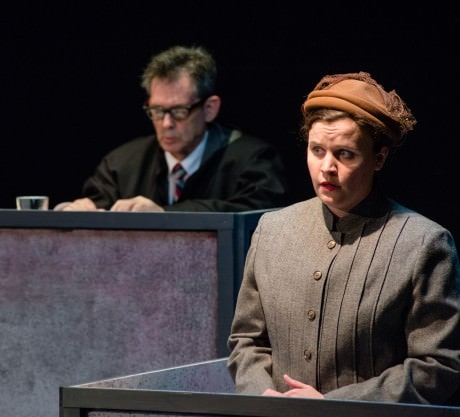A resounding round of applause is owed The American Century Theater (TACT), whose sharp, smart production of Judgment at Nuremberg brings this towering play to DC Metro audiences at last. As Artistic Director Jack Marshall has said: “It is stunning, and indeed an embarrassment, that this superb and important drama has never been performed professionally in the Washington area, where the Holocaust Museum and the World War II Memorial are located.”

With this TACT production, the DC Metro theater landscape just got another monument.
The play is a blunt, probing, shocking look back at the post–World War II war-crimes trial in Nuremberg, Germany, in which an Allied tribunal oversaw prosecution of German jurists for their role in the Nazis’ heinous human-rights abuses. It’s good-guy judges judging bad-guy judges—an explosive courtroom drama in which tremors at the fault lines of horror and honor, of complicity and conscience, become quakes that shake us and wake us from the complacency that comes of forgetting.
When theater does this best, it makes for some of the best theater. Theatergoers who get this will get Judgment at Nuremberg.
Marshall in a program note quotes something told him twenty years ago that prompted the origin of TACT:
Big issues—justice, war, bigotry, bias, the legal system, fairness, courage. Plays aren’t about big issues any more. Now, a drama is a ninety-minute, three-person play about roommates coming to terms with being vegetarians. It’s all small, timid stuff. [A]udiences don’t want to be challenged, or so theater companies think. Somebody needs to start producing the old plays that matter.
Judgment at Nuremberg is, hands down, a play that matters.
Some who know Judgment at Nuremberg from Stanley Kramer’s acclaimed 1961 film version—with its Oscar-winning screenplay by Abby Mann (who subsequently adapted it into the script being produced by TACT)—may be thinking: Seen that, done that. The movie is indeed magnificent. Its perch on every best-courtroom-drama list is assured. And though one need never have seen it to appreciate TACT’s gripping and haunting interpretation, attending to this particular play in live theater is its own distinctly rewarding experience.
The camera cannot always show a character’s reaction to what another character is saying; that’s a fact of the medium. There are reverse shots for that, so you rarely get to see the continuity in a character’s response. But if you catch Judgment at Nuremberg during its run at Gunston Arts Center, Theater II—which you would be remiss to miss—all the characters in every confrontation are constantly visible and the full field-of-vision effect can be extraordinary.

Take, for instance, the affecting scene when the defendants’ lawyer (the role for which Maximilian Schell won an Oscar) is interrogating the man whom the Nazis sterilized for having low intelligence (played memorably in the movie by Montgomery Clift). When Christopher Henley takes the stand as that damaged man, his shaken, fearful performance not only steals the scene; it becomes among the most moving moments of the play. We get to see Steve Lebens’ superb performance as the defense attorney throughout, but as he grills this prosecution witness, drills into him, damaging him even more, our eyes are on Henley’s—darting about, uncomprehending what is happening to him, broken, glazed with pain. We get to see into a character’s wounded soul as a camera could not have shown.
Take for another instance Director Joe Banno’s inspired staging, in which the stakes of the drama are heightened by having the audience seated in raked rows on either side of Set Designer Patrick Lord’s stark shades-of-gray courtroom—as if we are spectators split between two dispute-to-the-finish teams as no camera cutaway can convey. Sound Designer Sean Allan Doyle’s orchestral music interludes have a stirring sonority in the space unlike any movie sound track. Lord’s projections not only function deftly to shift scenes when the play’s action takes place outside the courtroom; they loom over the whole stage event; and when the prosecution offers vivid filmed glimpses of such atrocities as the judges on trial abetted, the visual effect is strangely more implicating than was the solely cinematic.
Banno’s brilliant directorial strokes include another that utterly transcends celluloid: he has cast an ensemble of spectral figures “from Hitler-era Nuremberg” (as he writes in his director’s note), who appear here and there throughout the show in “a silent dialogue with Mann’s eloquent writing.” I found these apparitions profoundly evocative as, for instance, they would cross paths with, and cast glances at, named characters during scene changes, or sit in the background in ghostly light like disappeared witnesses to the defendants’ crimes.
This is one of those shows one can’t stop thinking about and wanting—no, needing—to talk about. The complex tumult of moral, ethical, and legal issues at play in this trenchant script does not settle down anywhere easy. It raises a host of questions, some of which have a disturbing currency, especially given all the globe’s genocides and other human-rights abuses since. Everyone will have their own takeaway perplexity—some moral, ethical, or legal quandary that Abby Mann’s script insightfully points to. Mine was: How can there be a moral high ground at all?

It’s one thing to discern the moral low ground—the lethal nadir of humanity, the unprecedented depth dug by the Nazis. But on what basis did the United States among the Allied powers have the righteous right to judge? Judgment at Nuremberg astutely challenges that presumption, citing, for instance, Truman’s atomic bombing of Japanese civilians. And though not remarked in the play, what of this country’s Founding Genocide of indigenous peoples, or its systematic economic disenfranchisement on the basis of race. By what higher power (other than sanctimonious nostrums) can the U.S. claim the moral right to pass judgment on crimes against humanity?
The play Judgment at Nuremberg is more than worth seeing; now more than ever, it is necessary.
Running Time: Two hours, with one fifteen-minute intermission.
LINKS
Judgment at Nuremberg plays through June 28, 2014 at The American Century Theater performing at The Gunston Arts Center, Theatre II-2700 South Lang Street, in Arlington, VA. For tickets, call (703) 998-4555, or purchase them online.
A superb 42-page Audience Guide has been written and compiled by Jack Marshall to accompany TACT’s production of Judgment at Nuremberg. The Guide is available at the box office for a $4 donation and will be online after the show closes. Copies are also available free to those who attend apost-show discussion.
Listen to a podcast with Jack Marshall and members of the cast of Judgment at Nuremberg: Steve Lebens, Karin Rosnizeck, and Bruce Alan Rauscher.
https://youtu.be/_8pVElnR1M8




